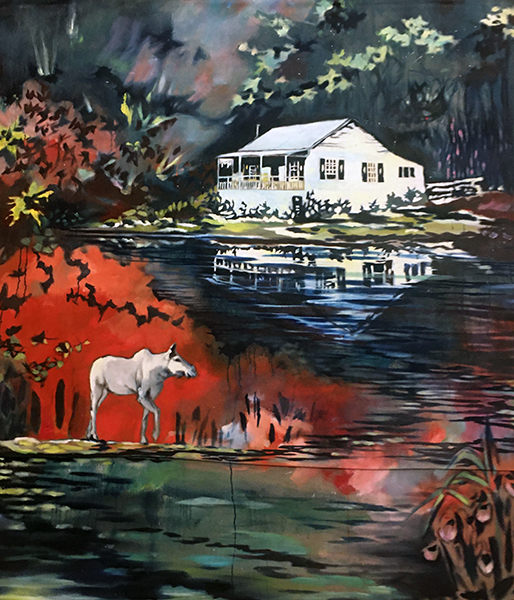
Anong Migwans Beam, Ghost Moose Camp, 2019, handmade oil paint on canvas, 182 x 121 cm
Anong Migwans Beam is an artist from Mchigeeng First Nation on Manitoulin Island. Her work draws inspiration from the physical history of place, the natural landscape, and the relationship between water and memory. Her large format oil paintings incorporate a multitude of image making approaches, including photo-transfer, printmaking, and collage.
Anong was born to artist parents, Carl Beam and Ann Beam, who encouraged her to develop as an artist. She was raised with a meaningful connection to both her artistic familial roots and rich ancestral heritage. Anong now operates a paint-manufacturing company, Beam Paints, which focuses on creating natural, high-quality artists materials with plastic-free packaging. Through making her own paints from natural, locally-sourced materials, Anong further strengthens her connection to the land, her community, and her artistic practice.
Anong writes:
For this exhibition I have created 6 large format oil on canvas paintings, and a small series of watercolour studies. In these works, I will be developing from a theme that has emerged in the past two years in my work. Looking at my life, and with my mother entering Alzheimer’s, I have been painting memories, my practice has always centred around water and how it holds and contains us, and is a silent witness again and again to all events, constantly renewed and present in us, as it was for our ancestors.
But now I am looking back and I feel like I am reclaiming histories for myself. I am inspired by images from other histories of place, like “Camp Forestia” by Peter Doig. It is a classic camp from the Ontario north, there are many all around me, and they are completely other, I have memories of seeing people go to them. They are the settler camps, even though they are so familiar, they are a visual image of privilege and isolation.
All around my home, even on reserve the waterfront belongs through long term lease to non-native families, who have held them for years. These paintings are emerging to reclaim images of where I live, and to relate them back to me. It’s strange to live somewhere and be of a place so fundamentally, but seeing it depicted only in a way that isolates my culture.
It is this medium and genre of oil on canvas. Sections of Tom Thomson’s “West Wind,” and “Jack Pine,” appear with Doig’s “Camp Forestia,” alongside a ghost moose, myself swimming in the lake, my boat in Swallow Lake at first snow. My father’s recurring image of a rocket launch, birds, and birds and birds! An old Cadillac, fireworks, lakes, birds, bears, and the stars . It is just immensely pleasurable to rectify this even if it is just in my paint-world . I love these painters as well and hold them to no ill will! Peter Doig, Tom Thomson, Kim Dorland, these men are painting their lives, and I am grateful to live in a time and place where I can do the same.
Also reaching deeper into art history, I’m happy to explore painting devices from Matisse (table with pansies, the joy of life), Botticelli’s “Birth of Venus,” Rothko’s colour pairings, Georgia O’Keefe’s skulls, and Agnes Martin’s grids which influenced my father, back into me, into dancing elk herds. It’s really something to be the child of a famous artist, it’s intense, and I’ve seen so much of the art world that is unkind, and unhealthy, I’ve seen my mother’s pain inside that she was not recognized like her husband. But all that pales in the joy that I feel creating these landscapes, internal, wishful, desirous, wanton, exploding! In some real ways they are ecstatic love stories to paint.
Being the first series where I have made all of my own oil paints, there is an incredible circuity to making paint from rocks from Bay Fine near Killarney, then painting that same scene with those rocks that are now paint! Each image that I make I feel and I fall immersed in the history of painting, learning devices from those who have already travelled this path.
Miigwetch.
This exhibition was originally curated by Elka Weinstein for the Campbell House Museum.
Video courtesy of Midland Cultural Centre
Did you know?
The Tugboat Mather was the last steam boat on the Lake of the Woods, retiring in 1960.
